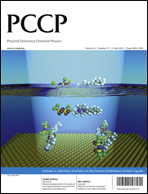Ultrathin films of the ionic liquid 1,3-dimethylimidazolium bis(trifluoromethylsulfonyl)imide ([C1C1Im][Tf2N]) were deposited on differently terminated Ni(111) single crystal surfaces. The initial wetting behaviour, the growth characteristics, the molecular arrangement at the interface, and thermal reactivity were investigated using angle-resolved X-ray photoelectron spectroscopy (ARXPS). On clean Ni(111), the initial growth occurs in a layer-by-layer mode. At submonolayer coverages up to at least 0.40 ML, a preferential arrangement of the IL ions in a bilayer structure, with the imidazolium cations in contact with the Ni surface atoms and the anions on top of the cation, is deduced. For higher coverages, a transition to a checkerboard-type arrangement occurs, which is most likely due to repulsive dipole–dipole interactions in the first layer. An overall preference for a checkerboard-type adsorption behaviour, i.e., anions and cations adsorbing next to each other, is found on the oxygen-precovered O(√3×√3)R30° Ni(111) surface. The thermal stability of adsorbed IL layers on Ni(111) and on a fully oxidised Ni(111) surface was studied by heating the layers to elevated temperatures. For clean Ni(111) reversible adsorption takes place. For the oxidised surface, however, only cation-related moieties desorb, starting at ∼450 K, while anion-related signals remain on the surface up to much higher temperatures.
![Graphical abstract: Interfaces of ionic liquids and transition metal surfaces—adsorption, growth, and thermal reactions of ultrathin [C1C1Im][Tf2N] films on metallic and oxidised Ni(111) surfaces](/en/Image/Get?imageInfo.ImageType=GA&imageInfo.ImageIdentifier.ManuscriptID=C2CP40278E&imageInfo.ImageIdentifier.Year=2012)

 Please wait while we load your content...
Please wait while we load your content...